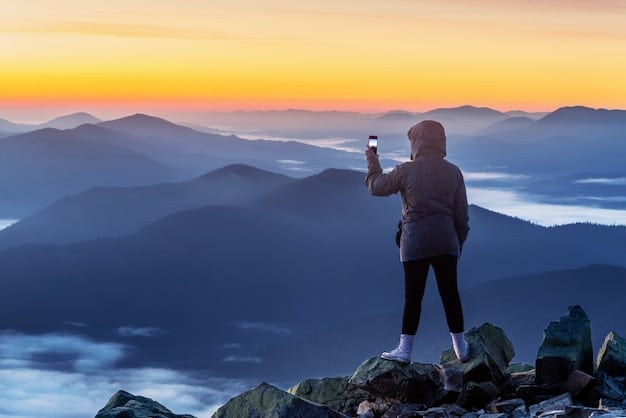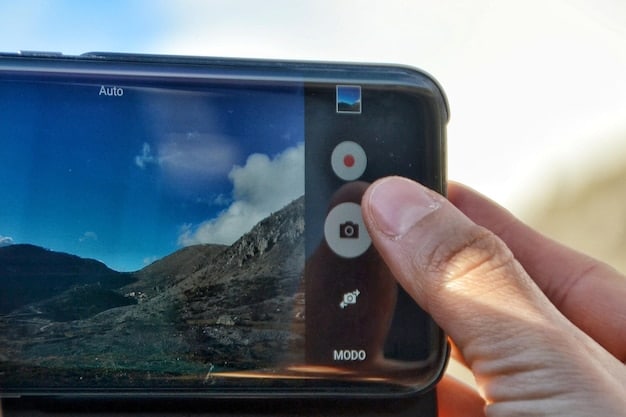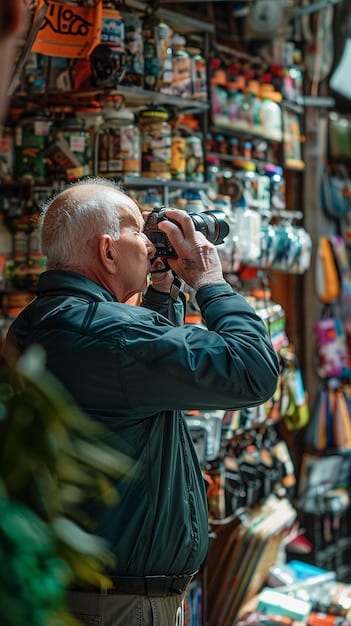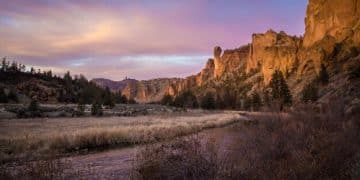Budget Travel Photography: Stunning Photos Without Breaking the Bank

Travel photography on a budget doesn’t require expensive gear; it’s about creativity and resourcefulness to capture stunning photos with affordable equipment and techniques.
Dreaming of capturing breathtaking travel photos but worried about the cost? You can achieve stunning results without emptying your wallet. Travel photography on a budget is entirely possible with the right strategies and a resourceful mindset. Let’s explore how to create amazing images without expensive gear.
Embrace the Power of Your Smartphone
Your smartphone is likely the most powerful camera you already own. Modern smartphones boast impressive camera capabilities, often rivalling dedicated cameras from just a few years ago. Learning to maximize your phone’s potential is the first step in budget-friendly travel photography. Understand its strengths and limitations to get the best results.
Master Your Phone’s Camera Settings
Dive into your phone’s camera settings to uncover hidden features and manual controls. Experiment with different modes, such as HDR, portrait mode, and panorama. Familiarize yourself with adjusting ISO, aperture (if available), and white balance to fine-tune your shots. Learn how to lock the focus to ensure sharp images.
Utilize Third-Party Camera Apps
Enhance your smartphone’s capabilities with third-party camera apps. Apps like “Camera+ 2” or “ProCam” offer advanced manual controls, RAW image capture, and customizable settings, giving you more creative control over your photos. These apps often provide features missing from the stock camera app.

Beyond the settings and apps, experiment with using your phone in new ways:
- Rule of Thirds: Enable the grid overlay on your phone’s camera to compose your shots using the rule of thirds for balanced and visually appealing images.
- Clean Your Lens: A simple but often overlooked tip – ensure your lens is clean to avoid blurry or distorted photos.
- Shoot in Good Lighting: Smartphones perform best in well-lit conditions. Take advantage of natural light whenever possible.
- Edit on Your Phone: Utilize mobile editing apps like Snapseed or Lightroom Mobile to enhance your photos directly on your phone.
By mastering your smartphone’s camera and utilizing readily available apps, you can capture incredible travel photos without investing in expensive equipment. Embrace its capabilities and experiment to discover what your phone can achieve. Understanding these strategies can significantly elevate the quality of your travel photography.
Affordable Alternatives to Expensive Gear
While expensive cameras and lenses can offer exceptional quality, there are numerous affordable alternatives that deliver excellent results. Consider investing in used equipment, versatile lenses, and readily available photography accessories. Smart choices can significantly improve your photography without breaking the bank.
Explore the Used Market for Cameras and Lenses
The used market is a treasure trove for budget-conscious photographers. Websites like KEH Camera, MPB, and local classifieds offer a wide selection of used cameras and lenses at significantly lower prices than new equipment. Thoroughly research the equipment and check its condition before making a purchase.
Opt for Versatile Prime Lenses
Instead of purchasing multiple expensive zoom lenses, consider a versatile prime lens. Prime lenses, such as a 35mm or 50mm, often offer wider apertures for better low-light performance and shallower depth of field for creative portraits. They are also typically sharper and more affordable than zoom lenses.
Here are a few affordable accessories that can significantly enhance your travel photography:
- Tripod: A lightweight travel tripod is essential for landscape photography and capturing sharp images in low-light conditions.
- External Microphone: If you plan to shoot video, an external microphone can drastically improve audio quality.
- Portable Reflector: A reflector can bounce light onto your subject, filling in shadows and creating more flattering portraits.
- Lens Filters: Invest in a polarizing filter to reduce glare and enhance colors, and a neutral density filter to control exposure in bright conditions.

By exploring the used market for cameras and lenses, opting for versatile prime lenses, and investing in affordable accessories, you can significantly enhance your travel photography without excessive spending. Consider these options to maximize your budget and achieve professional-looking results.
Mastering the Art of Composition
Composition is one of the most important elements of photography, and it doesn’t cost a thing! Learning and applying fundamental compositional techniques can dramatically improve your images. Focus on elements like the rule of thirds, leading lines, symmetry, and framing to create visually compelling and engaging photos.
The Rule of Thirds
The rule of thirds is a fundamental compositional guideline that involves dividing your image into nine equal parts using two horizontal and two vertical lines. Placing key elements of your scene along these lines or at their intersections creates a more balanced and visually appealing composition. This technique guides the viewer’s eye through the image.
Leading Lines
Leading lines are lines within your image that draw the viewer’s eye towards a specific point. These lines can be roads, rivers, fences, or any other linear element in the scene. Effectively using leading lines can create a sense of depth and guide the viewer’s attention to the subject of your photo.
Symmetry and Patterns
Symmetry and patterns can create striking and visually pleasing compositions. Look for symmetrical scenes or repeating patterns in architecture, nature, or urban environments. Capturing these elements can create a sense of order and harmony in your photos. Positioning yourself to emphasize these aspects can make your image more impactful.
Here are more compositional techniques to consider:
- Framing: Use elements within the scene, such as trees, arches, or windows, to frame your subject and draw attention to it.
- Negative Space: Incorporate negative space around your subject to create a sense of balance and emphasize its importance.
- Depth of Field: Use a shallow depth of field to isolate your subject and blur the background, or a deep depth of field to keep the entire scene in focus.
- Point of View: Experiment with different angles and viewpoints to capture unique perspectives and add visual interest to your photos.
Utilizing Natural Light and Timing
Light is the most crucial element in photography, and understanding how to use natural light effectively can dramatically improve your photos. Pay attention to the time of day and weather conditions to capture the best light for your scenes. Golden hour and blue hour are especially favorable times for photography.
The Golden Hour
The golden hour, the hour after sunrise and the hour before sunset, is renowned for its warm, soft, and diffused light. This light creates flattering shadows and highlights, making it ideal for portraits, landscapes, and cityscapes. Plan your shoots during the golden hour to capture the most beautiful light.
The Blue Hour
The blue hour, the period shortly before sunrise and after sunset, offers a cool, soft, and ethereal light. During this time, the sky takes on a deep blue hue, creating a magical atmosphere for photography. The blue hour is particularly well-suited for capturing cityscapes and night scenes.
Shooting in Cloudy Weather
Don’t be discouraged by cloudy weather. Overcast days can provide soft, diffused light that is perfect for portraits and minimizing harsh shadows. Clouds act as a natural diffuser, creating even lighting that is flattering for subjects. Embrace cloudy days as an opportunity to capture unique and atmospheric photos.
Here are some tips for mastering natural light:
- Observe the Light: Pay attention to how the light changes throughout the day and how it affects different scenes.
- Positioning: Position yourself and your subject to take advantage of the available light.
- Shadows: Use shadows creatively to add depth and dimension to your photos.
- Reflections: Look for reflective surfaces, such as water or glass, to add visual interest and create unique perspectives.
Editing and Post-Processing on a Budget
Post-processing is an essential part of the photography workflow, allowing you to enhance your images and bring out their full potential. Fortunately, there are numerous free and affordable editing tools available. Mastering basic editing techniques can significantly improve the quality of your travel photos without costing a fortune.
Free Mobile Editing Apps: Snapseed and Lightroom Mobile
Snapseed and Lightroom Mobile are two of the most popular and powerful free mobile editing apps. Snapseed offers a wide range of tools and filters for basic adjustments, selective editing, and creative effects. Lightroom Mobile provides advanced editing capabilities, including RAW image support, color correction, and preset creation.
Affordable Desktop Editing Software: GIMP and Darktable
For desktop editing, GIMP and Darktable are excellent free and open-source alternatives to expensive software like Adobe Photoshop. GIMP offers a comprehensive set of tools for image manipulation, retouching, and graphic design. Darktable is specifically designed for photographers, providing advanced RAW processing and color management capabilities.
Basic Editing Techniques
Mastering basic editing techniques can dramatically improve your photos. Start with adjustments such as:
- Exposure: Adjust the overall brightness of your image to ensure it is neither too dark nor too bright.
- Contrast: Increase contrast to enhance the difference between light and dark areas, creating a more visually dynamic image.
- White Balance: Correct the color temperature of your image to ensure accurate and natural colors.
- Saturation: Adjust the intensity of colors to make them more vibrant or muted.
Other essential editing practices include:
- Sharpening: Enhance the sharpness of your image to bring out details and textures.
- Noise Reduction: Reduce noise or graininess in your photos, especially in low-light conditions.
- Cropping: Crop your image to improve composition, remove distractions, and focus on the subject.
- Straightening: Correct any tilting or perspective distortions in your image.
Storytelling Through Your Travel Photos
Ultimately, the best travel photos tell a story. Think about the narrative you want to convey with your images. Focus on capturing authentic moments, emotions, and cultural details that reflect the essence of your travel experiences. Engaging storytelling elevates your photography beyond simple snapshots.
Capture Authentic Moments
Look for candid and unposed moments that capture the genuine essence of your travel experiences. These moments often reveal more about the culture, people, and atmosphere of a place than staged photographs. Be patient and observant, and be ready to capture those fleeting moments as they unfold.
Show Emotions and Expressions
Focus on capturing emotions and expressions in your subjects. A genuine smile, a thoughtful gaze, or a look of wonder can add depth and meaning to your photos. Connect with your subjects and build rapport to create a comfortable and authentic environment for capturing these moments.
Include Cultural Details
Pay attention to cultural details that reflect the unique identity of a place. These details can include traditional clothing, local customs, street scenes, architecture, and cuisine. Incorporating these elements into your photos can provide context and create a more immersive viewing experience.
To tell your travel story:
- Research: Learn about the history, culture, and people of the places you visit.
- Focus: Focus on a specific theme or narrative for your travel photography project.
- Sequence: Arrange your photos in a logical and compelling sequence to create a cohesive story.
- Captions: Write informative and engaging captions to provide context and enhance the storytelling.
| Key Takeaway | Brief Description |
|---|---|
| 📱 Smartphone Power | Maximize your phone’s camera potential with settings and apps. |
| 📷 Used Gear | Explore used markets for affordable cameras and versatile lenses. |
| 💡 Natural Light | Utilize golden and blue hours for optimal lighting. |
| ✨ Storytelling | Capture authentic moments and emotional expressions to tell a compelling story. |
Show Emotions and Expressions
Show Emotions and Expressions
Show Emotions and Expressions
FAQ
▼
A smartphone with a good camera is often the best starting point. Alternatively, consider a used DSLR or mirrorless camera with a versatile prime lens for better image quality.
▼
Learn to use your phone’s manual settings, utilize gridlines for composition, and edit your photos using free mobile apps like Snapseed or Lightroom Mobile.
▼
A lightweight travel tripod, an external microphone (if you shoot video), a portable reflector, and lens filters (polarizing and neutral density) are all valuable accessories.
▼
Shoot during the golden hour (shortly after sunrise and before sunset) for warm, soft light, or during the blue hour for cool, ethereal light. Embrace cloudy days for diffused, even lighting.
▼
Snapseed and Lightroom Mobile are excellent free mobile apps. For desktop editing, GIMP and Darktable are powerful open-source alternatives to paid software.
Conclusion
Embarking on travel photography on a budget is not only possible but can also be incredibly rewarding. By embracing the power of your smartphone, exploring affordable alternatives to expensive gear, mastering the art of composition, utilizing natural light, and honing your editing skills, you can capture stunning photos that tell compelling stories without breaking the bank. Happy shooting!





